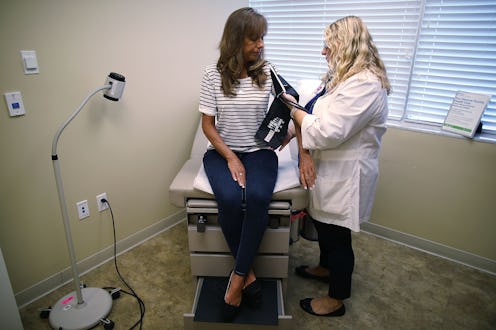News
One Researcher Explains What People In America's "Abortion Deserts" Must Do To Get Care

A recent study published by the University of California San Francisco's Advancing New Standards in Reproductive Health (ANSIRH) research group highlighted America's "abortion deserts" and how they affect people seeking to terminate unwanted pregnancies. The study, which was published in the Journal of Medical Internet Research on Monday, reported that there are 27 "abortion deserts" in the country — a term used to refer to cities where the lack of abortion facilities may force people to travel over 100 miles to get abortion services.
Although there were 780 abortion centers in the United States, these facilities were not evenly spread throughout the country, the study found. ANSIRH's project director and one of the main authors behind the study, Alice Cartwright, tells Bustle that the purpose of conducting the study was to understand how Americans navigate the "intersection of digital health and reproductive health."
"More and more these days, it's [about] going on Google and searching for 'abortion clinic' or something like that," she says. "We wanted to model what it would look like for the average person searching online."
The study's conclusions paint a deeply troubling picture of reproductive health care and access in the United States. For instance, ANSIRH's research says that Texas has the highest number of abortion deserts than any other American state. With 10 cities that lack abortion facilities, the Lone Star State seems to be particularly challenging for people who may be seeking abortion care.
"It really demonstrated to us that there are huge swaths of the country where people have to travel so far that they may just decide that the barriers of getting to an abortion clinic are [high] — they can't overcome them," Cartwright says. "So, they may choose to carry the pregnancy to term and parent that pregnancy when they may have preferred to have an abortion."
Texas' case of abortion deserts has been studied over the past few years. In 2015, the University of Texas' Texas Policy Evaluation Project reported that the waiting time for people seeking abortion services in Texas had shot up to 20 days in places like Dallas, Fort Worth, and Austin due to state-level restrictions on abortion care.
The study also dug into regional abortion facilities and reported that the American Northeast region had the highest number of options, with 233 abortion centers spread over nine states. In contrast to the Northeast, America's Midwest has the lowest number of abortion centers with only 92 facilities dotting a total of 10 states.
The ANSIRH paper also noted that North Dakota, South Dakota, Missouri, Kentucky, West Virginia, and Mississippi were the six states with only one abortion center in each.
Abortion deserts affect the day-to-day lives of the people seeking abortion services, including having to arrange for day care if they already have children, taking time off from their jobs, preparing for more than one appointment, and paying for travel expenses. Cartwright highlights the intricate detail that goes into such travel and how it impacts people, especially those who are working-class. "What does it actually for someone to travel even five miles? Or 10 miles? They might have to get on three buses or take a train to a bus," she says.
ANSIRH's research was published shortly after the reproductive health research organization Guttmacher Institute released research in January that reported there had been 400 state laws targeting abortion services between 2011 and 2017, contributing to abortion centers shutting down across the country.
Perhaps with ANSIRH's study, the hold that abortion deserts have on people can be understood — and mitigated. "This is the first time that we have done [this research] in such a systematic way," Cartwright says. "I definitely hope that we continue this methodology annually."